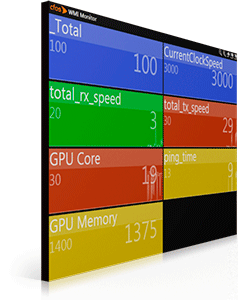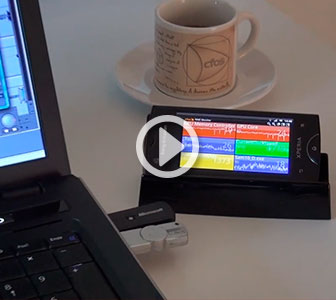
cFos WMI Monitor, a cFos Personal Net add-on package
Monitor vital WMI data on your PC or smartphone.
Free addon package for cFos Personal Net users.
The cFos WMI Monitor allows to display nearly all WMI values about your system, for example CPU load, GPU load, network usage, ping time, etc.
Access these WMI values from anywhere.
Installation
Download and install the cFos WMI Monitor package. It contains scripts and HTML pages for the cFos WMI Monitor. In addition it also contains a cFos Personal Net version. If your version is older than the one in the cFos WMI Monitor package your cFos PNet version will be automatically updated.
To prevent others from accessing your WMI data, the cFos WMI Monitor requires a valid user by means of HTTP authentication. So you should configure a user, for example admin in cFos PNet. You can do this by re-running the setup. Or you can add a new user, for example user wmi, by opening /users/index.htm as admin.
To make the most of cFos WMI Monitor we recommend to install
- cFosSpeed, our Internet accelerator. It's built-in WMI provider makes the following WMI values available:
- total RX speed
- total TX speed
- ping time
- TCP/UDP connection count
- RX cps
- TX cps
Windows WMI values correspond to the current network adapter, regardless of LAN or Internet traffic. You can display all values which are displayed in the cFosSpeed status window. - Open Hardware Monitor. It also has a built-in WMI provider which can display very useful hardware values, like
- CPU load and temperature
- GPU load and temperature
Using cFos WMI Monitor

This video shows the cFos WMI Monitor during "gameplay", so you can see how your CPU, GPU and network connection performs.
Ensure cFos PNet is running. If you want to run cFos WMI Monitor on your local machine, enter localhost/wmi/wmi.htm into the web browser's address line. To run it from a smartphone, tablet or other PC in your LAN, find out the local address of your local machine, e.g. 192.168.2.123. Then enter 192.168.2.123/wmi/wmi.htm into the web browser's address line.
You may want to save this webpage as favorite or at your smartphone's/tablet's start page for easy access.
Now wait!! Unfortunately the Windows WMI host can be very slow. It may take several minutes until the default CPU load value is displayed.
Once WMI is ready you can add new WMI values or click on existing ones to configure their position and color.
The first "Presets" menu offers (in our opinion) very useful values, like CPU load and frequency as well as network adapter send and receive speed. It also contains interesting cFosSpeed and Open Hardware Monitor values.
The second "Processes" menu lists all currently running Windows processes, so you can use cFos WMI Monitor to monitor processes. cFos WMI Monitor displays the CPU usage of the processes or N/A if the process is not running anymore. So cFos WMI Monitor can serve as a process watch dog.
The last menu gives you a way to chose arbitrary WMI values. Use . to select your current computer (the machine where cFos PNet is running) or the Windows network address of another computer with a WMI provider active. Then you need to select the WMI namespace. root\cimv2 is the default Windows namespace, root\cfos is the namespace for cFosSpeed and root\OpenHardwareMonitor is the namespace for Open Hardware Monitor. Then you need to select a WMI class and then an instance key, to tell cFos WMI Monitor which object you want to get displayed. For example you could select the number of a certain CPU core, for which you want to display the CPU load value. The last parameter tells cFos WMI Monitor the actual value you want to display.